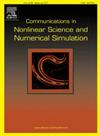利用双稳态非线性能量汇抑制涡激振动
IF 3.4
2区 数学
Q1 MATHEMATICS, APPLIED
Communications in Nonlinear Science and Numerical Simulation
Pub Date : 2025-05-22
DOI:10.1016/j.cnsns.2025.108952
引用次数: 0
摘要
利用传统的三次非线性能量汇(NES)来减轻涡激振动已经得到了广泛的研究。近年来,双稳态井内井(BNES)由于能够进行大幅度的井间运动,从而增强能量传递,引起了相当大的关注。但是,BNES在一般情况下减轻自激振动,特别是涡激自激振动方面的效果似乎很少受到关注。本研究提出使用BNES来减轻受流场影响的弹性安装圆柱的振动。采用具有加速度耦合的范德波尔方程来模拟尾迹行为。BNES附加在线性结构上。进行了分析和数值研究,以了解能量传递的机制,并证明了BNES相对于传统立方NES的优势。数值研究表明,BNES在锁紧区域具有较好的减振效果。与立方NES一样,BNES的包含使锁定区内的大振幅同步轨道失稳。与立方网相比,BNES表现出井间混沌运动的能力可以产生更大的振动抑制。利用Melnikov分析进一步研究了井内周期混沌运动向井间混沌运动的过渡,得到了过渡所需的临界响应幅值。采用复平均法(CX-A)与多尺度法(MMS)相结合的方法,从慢流动力学中导出慢不变流形(SIM)。SIM拓扑结构和预测时间历史证明了BNES比立方NES在抑制涡激振动方面的优势。研究了质量比、负线性刚度、无量纲阻尼和刚度比等因素对SIM拓扑结构的影响。在此基础上,提出了有效抑制振动的最佳BNES参数。本文章由计算机程序翻译,如有差异,请以英文原文为准。
Suppression of vortex-induced vibrations using bistable nonlinear energy sink
The use of conventional cubic nonlinear energy sink (NES) to mitigate vortex-induced vibrations has been widely investigated. Recently, bistable NES (BNES) has gained considerable attention owing to its ability to execute large amplitude inter-well motion and thus enhance energy transfer. But, the efficacy of BNES to mitigate self-excited vibrations in general and vortex-induced self-excited vibrations in particular seems to have received little interest. The present study proposes the use of BNES to mitigate the vibration of an elastically mounted circular cylinder subjected to a flow field. The van der Pol equation with acceleration coupling is used to model the wake behavior. The BNES is appended to the linear structure. Analytical and numerical investigations are performed to understand the mechanism of energy transfer and to demonstrate the advantages of BNES over conventional cubic NES. Numerical studies reveal that the BNES is more effective in reducing vibration amplitude in the lock-in region. Like cubic NES, the inclusion of BNES de-stabilizes the large amplitude synchronized orbits in the lock-in region. The ability of BNES to exhibit inter-well chaotic motion is shown to cause larger vibration mitigation when compared with cubic NES. The transition from the intra-well periodic to inter-well chaotic motion is further investigated by Melnikov analysis, and the critical response amplitude needed for the same is arrived at. The complex-averaging (CX-A) method combined with the method of multiple scales (MMS) is used to derive the slow invariant manifold (SIM) from the slow-flow dynamics. The SIM topology, together with the projected time history, is used to demonstrate the advantages of BNES over cubic NES in vortex-induced vibration suppression. The effect of mass ratio, negative linear stiffness, non-dimensional damping, and stiffness ratio on the topology of SIM is investigated. Based on this parameter study, optimal BNES parameters for effective vibration suppression are suggested.
求助全文
通过发布文献求助,成功后即可免费获取论文全文。
去求助
来源期刊

Communications in Nonlinear Science and Numerical Simulation
MATHEMATICS, APPLIED-MATHEMATICS, INTERDISCIPLINARY APPLICATIONS
CiteScore
6.80
自引率
7.70%
发文量
378
审稿时长
78 days
期刊介绍:
The journal publishes original research findings on experimental observation, mathematical modeling, theoretical analysis and numerical simulation, for more accurate description, better prediction or novel application, of nonlinear phenomena in science and engineering. It offers a venue for researchers to make rapid exchange of ideas and techniques in nonlinear science and complexity.
The submission of manuscripts with cross-disciplinary approaches in nonlinear science and complexity is particularly encouraged.
Topics of interest:
Nonlinear differential or delay equations, Lie group analysis and asymptotic methods, Discontinuous systems, Fractals, Fractional calculus and dynamics, Nonlinear effects in quantum mechanics, Nonlinear stochastic processes, Experimental nonlinear science, Time-series and signal analysis, Computational methods and simulations in nonlinear science and engineering, Control of dynamical systems, Synchronization, Lyapunov analysis, High-dimensional chaos and turbulence, Chaos in Hamiltonian systems, Integrable systems and solitons, Collective behavior in many-body systems, Biological physics and networks, Nonlinear mechanical systems, Complex systems and complexity.
No length limitation for contributions is set, but only concisely written manuscripts are published. Brief papers are published on the basis of Rapid Communications. Discussions of previously published papers are welcome.
 求助内容:
求助内容: 应助结果提醒方式:
应助结果提醒方式:


